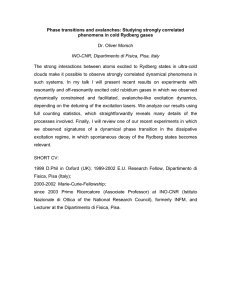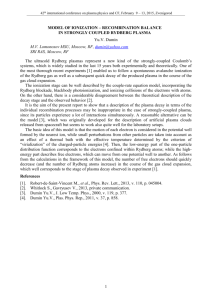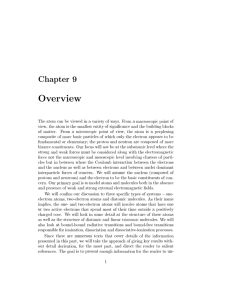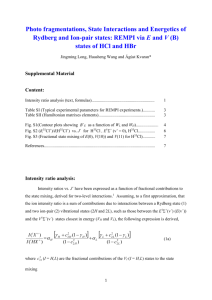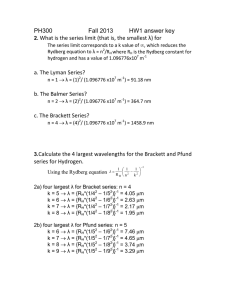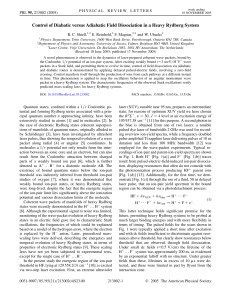Observation of Coherent Wave Packets in a Heavy Rydberg System V 1
advertisement
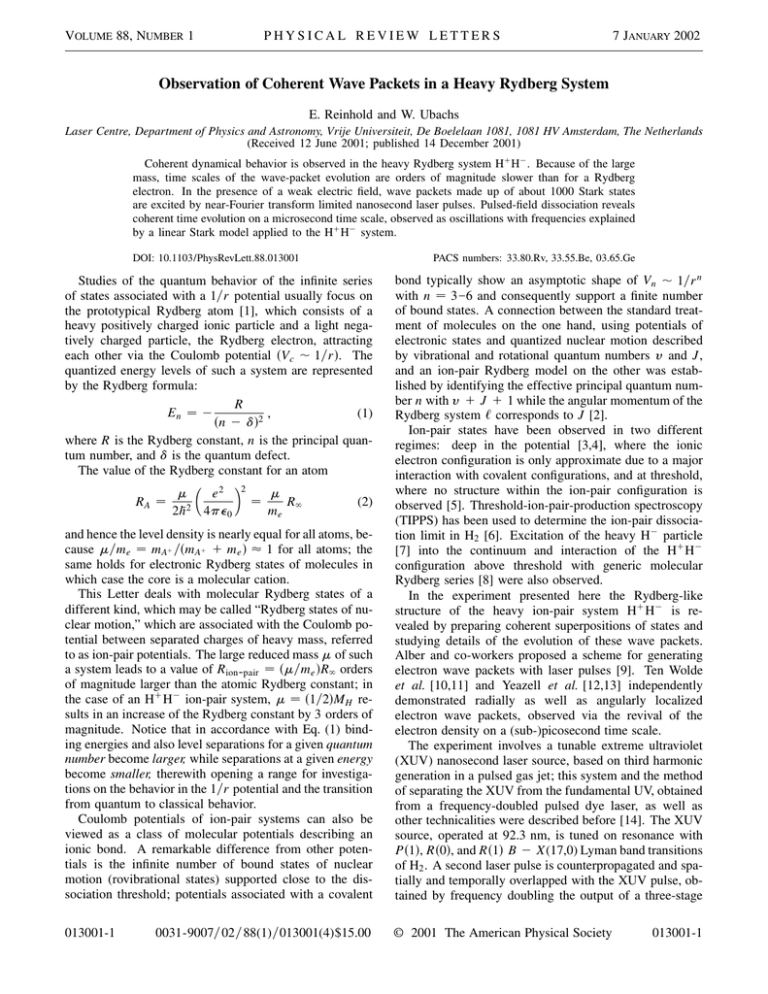
VOLUME 88, NUMBER 1 PHYSICAL REVIEW LETTERS 7 JANUARY 2002 Observation of Coherent Wave Packets in a Heavy Rydberg System E. Reinhold and W. Ubachs Laser Centre, Department of Physics and Astronomy, Vrije Universiteit, De Boelelaan 1081, 1081 HV Amsterdam, The Netherlands (Received 12 June 2001; published 14 December 2001) Coherent dynamical behavior is observed in the heavy Rydberg system H1 H2 . Because of the large mass, time scales of the wave-packet evolution are orders of magnitude slower than for a Rydberg electron. In the presence of a weak electric field, wave packets made up of about 1000 Stark states are excited by near-Fourier transform limited nanosecond laser pulses. Pulsed-field dissociation reveals coherent time evolution on a microsecond time scale, observed as oscillations with frequencies explained by a linear Stark model applied to the H1 H2 system. DOI: 10.1103/PhysRevLett.88.013001 PACS numbers: 33.80.Rv, 33.55.Be, 03.65.Ge and hence the level density is nearly equal for all atoms, because m兾me 苷 mA1 兾共mA1 1 me 兲 艐 1 for all atoms; the same holds for electronic Rydberg states of molecules in which case the core is a molecular cation. This Letter deals with molecular Rydberg states of a different kind, which may be called “Rydberg states of nuclear motion,” which are associated with the Coulomb potential between separated charges of heavy mass, referred to as ion-pair potentials. The large reduced mass m of such a system leads to a value of Rion-pair 苷 共m兾me 兲R` orders of magnitude larger than the atomic Rydberg constant; in the case of an H1 H2 ion-pair system, m 苷 共1兾2兲MH results in an increase of the Rydberg constant by 3 orders of magnitude. Notice that in accordance with Eq. (1) binding energies and also level separations for a given quantum number become larger, while separations at a given energy become smaller, therewith opening a range for investigations on the behavior in the 1兾r potential and the transition from quantum to classical behavior. Coulomb potentials of ion-pair systems can also be viewed as a class of molecular potentials describing an ionic bond. A remarkable difference from other potentials is the infinite number of bound states of nuclear motion (rovibrational states) supported close to the dissociation threshold; potentials associated with a covalent bond typically show an asymptotic shape of Vn ⬃ 1兾r n with n 苷 3 6 and consequently support a finite number of bound states. A connection between the standard treatment of molecules on the one hand, using potentials of electronic states and quantized nuclear motion described by vibrational and rotational quantum numbers y and J, and an ion-pair Rydberg model on the other was established by identifying the effective principal quantum number n with y 1 J 1 1 while the angular momentum of the Rydberg system ᐉ corresponds to J [2]. Ion-pair states have been observed in two different regimes: deep in the potential [3,4], where the ionic electron configuration is only approximate due to a major interaction with covalent configurations, and at threshold, where no structure within the ion-pair configuration is observed [5]. Threshold-ion-pair-production spectroscopy (TIPPS) has been used to determine the ion-pair dissociation limit in H2 [6]. Excitation of the heavy H2 particle [7] into the continuum and interaction of the H1 H2 configuration above threshold with generic molecular Rydberg series [8] were also observed. In the experiment presented here the Rydberg-like structure of the heavy ion-pair system H1 H2 is revealed by preparing coherent superpositions of states and studying details of the evolution of these wave packets. Alber and co-workers proposed a scheme for generating electron wave packets with laser pulses [9]. Ten Wolde et al. [10,11] and Yeazell et al. [12,13] independently demonstrated radially as well as angularly localized electron wave packets, observed via the revival of the electron density on a (sub-)picosecond time scale. The experiment involves a tunable extreme ultraviolet (XUV) nanosecond laser source, based on third harmonic generation in a pulsed gas jet; this system and the method of separating the XUV from the fundamental UV, obtained from a frequency-doubled pulsed dye laser, as well as other technicalities were described before [14]. The XUV source, operated at 92.3 nm, is tuned on resonance with P共1兲, R共0兲, and R共1兲 B 2 X(17,0) Lyman band transitions of H2 . A second laser pulse is counterpropagated and spatially and temporally overlapped with the XUV pulse, obtained by frequency doubling the output of a three-stage 013001-1 © 2001 The American Physical Society Studies of the quantum behavior of the infinite series of states associated with a 1兾r potential usually focus on the prototypical Rydberg atom [1], which consists of a heavy positively charged ionic particle and a light negatively charged particle, the Rydberg electron, attracting each other via the Coulomb potential 共Vc ⬃ 1兾r兲. The quantized energy levels of such a system are represented by the Rydberg formula: R En 苷 2 , (1) 共n 2 d兲2 where R is the Rydberg constant, n is the principal quantum number, and d is the quantum defect. The value of the Rydberg constant for an atom µ 2 ∂2 e m m RA 苷 (2) 苷 R` 2h̄2 4pe0 me 0031-9007兾02兾 88(1)兾013001(4)$15.00 013001-1 VOLUME 88, NUMBER 1 7 JANUARY 2002 PHYSICAL REVIEW LETTERS pulsed extraction field with respect to the laser pulses, does not show an exponential decay: A pronounced oscillation with a number of sharp minima is found, superimposed on a decay transient, as shown in Fig. 2 for a typical case. Oscillation periods between 40 and 500 ns have been observed, extending to a total delay of up to 1 ms, depending on the binding energy below the ion-pair threshold and the strength of the static electric field. This oscillatory structure can be understood as dynamical behavior of a coherently excited wave packet of Stark states of the H1 H2 system. Rydberg states split up by the linear Stark effect, resulting in eigenstates that are superpositions of angular momentum components spanning the entire range 0 # J , n. For individual optically excited states this results in an increase of lifetime, which is determined by decay near the core and therefore shows an n3 dependence; components with higher angular momentum are non-core-penetrating, leading to an increase of lifetimes with n4 , which is an effect known from high atomic Rydberg states in ZEKE [15]. To apply textbook formulas of the atomic Stark effect to ion-pair systems, quantities like the Rydberg constant need to be scaled with the heavy mass of the system. In analogy to atomic units, “ion-pair units” can be introduced to describe ion-pair states by substituting the electron mass me in the definition of atomic units with the reduced mass m of the ion-pair system. Each unit scales with a characteristic power of M :苷 m兾me (M 苷 918.5761 for H1 H2 ): The Rydberg constant goes linearly with M, leading to a value of 1.008 020 7 3 108 cm21 ; the Bohr radius decreases by 1兾M to 5.760 842 3 10214 m, and the unit of electric field strength scales by M 2 leading to a value ion signal [arb. units] pulsed-dye-amplifier system seeded by a single-mode ring dye laser. The tunable light in the range 310–330 nm has a bandwidth of 150 MHz, which is almost the Fouriertransform limit for a pulse duration of 艐5 ns. The laser beams cross a collimated, skimmed, and pulsed beam of H2 in the interaction zone, where an adjustable homogeneous electric field of several V兾cm can be applied. A Doppler width of DnD 苷 1 GHz on the second excitation step was measured via another field-free excitation in H2 to a bound state. The laser excitation scheme is indicated in Fig. 1 with the relevant potentials of molecular hydrogen and energy levels. Excitation is performed in a small static electric field. After excitation a 25 V兾cm pulse with variable delay is applied to field-dissociate weakly bound ion-pair states, similar to field ionization of Rydberg states, thus probing states with binding energies up to 30 cm21 . The static field is oriented antiparallel to the pulsed field in order to draw ions produced in advance of the field pulse away from the time-of-flight tube onto the opposite field plate. Depending on field polarity, either H1 or H2 ions are detected after time-offlight mass separation. Frequencies were chosen to excite H1 H2 states bound by 8.5 26 cm21 below the dissociation threshold at 139 713.84 cm21 above the ground state of H2 [6], corresponding to the principal quantum numbers of n 苷 2000 3500. The central observation made in the present experiment is that the ion yield signal, as a function of delay of the 0 FIG. 1. Potential curves of H2 , showing the pathway of twostep excitation of the H1 H2 system interacting with Rydberg states at a small internuclear distance. The inset shows the H1 H2 potential on a larger scale together with the fourth dissociation threshold of H2 ; the shaded region indicates observed bound ion-pair states. 013001-2 200 400 delay [ns] 600 FIG. 2. Observed H1 spectrum as a function of pulsed field delay (field trigger with respect to the laser pulses) at a binding energy of 13.7 cm21 at F 苷 2 V兾cm, excited via B, y 苷 17, J 苷 0. The thin line indicates the ideally expected signal for the observed recurrence period and decay transient. 013001-2 of 4.338 901 3 1017 V兾m. Formulas for, e.g., the Rydberg state energies E 苷 21兾2n2 , the classical orbital size R 苷 n2 , and level spacings DE 苷 1兾n3 can thus be applied to ion-pair states when they are interpreted in ion-pair units. It follows that ion-pair states with a given principal quantum number are much more strongly bound and have much smaller orbitals than the corresponding Rydberg states. For small quantum numbers this leads to unphysical values for molecular energies and bond lengths, but due to the nonvanishing size of the ions this regime is never reached. Equations describing the Stark level spacing ds 苷 3Fn, the width of an entire Stark manifold Ds 苷 3Fn共n 2 1兲, and the Inglis-Teller (IT) limit (the field strength at which the width of the Stark manifold equals the Rydberg state splitting) FIT 艐 1兾共3n5 兲 are applied to the H1 H2 system while understood in ion-pair units. One finds ds 苷 5 20 MHz for the Stark level spacing at the binding energies investigated here and static fields of F 苷 0.25 3 V兾cm. Within the laser bandwidth of 150 MHz a large number of Stark states are accessible to excitation on energetic argument alone: 10 –30 Stark states belonging to a principal quantum number can be excited coherently, and because Stark manifolds of many principal quantum numbers overlap, typically 100 –200 states with different principal quantum numbers may contribute to a coherent superposition of excited states. However, angular momentum selection rules and the Franck-Condon principle strongly restrict the excitation possibilities. The resulting superposition can be best discussed in terms of a wave packet with distinct properties of angular and radial motion. The coherent width of the laser pulse, being more than 10 times the Stark splitting, implies that within the pulse duration the angular momentum is a nearly conserved quantity. Therefore the wave packet initially excited contains only components with low J, which are of course coherent superpositions of the full manifold of Stark states. The properties of radial motion are governed by the excitation from the B state at small internuclear distance (i.e., R , 10a0 ). The presence of hundreds of states with different n in the energy region in question does not imply that the wave packet is localized radially, because all these states have different Stark quantum numbers k as well. What is important is the splitting of states of principle quantum number states with the same k, which is larger than the coherent width of the laser pulse (at n 苷 3000 the splitting between consecutive n states is 220 MHz, while the laser bandwidth is 150 MHz). This means that the Kepler time of a radial wave packet with any given k is shorter than the pulse length, implying that the entire R space is filled with wave function density during excitation and that radial wave-packet dynamics is essentially absent. The high-n H1 H2 ion-pair states have their wave function density at large R, far beyond 10a0 , so outside the Franck-Condon region of the B state. It is assumed that the excitation probability derives from the interaction with 013001-3 7 JANUARY 2002 PHYSICAL REVIEW LETTERS autoionizing electronic Rydberg states, similar to the case of TIPPS [6]. Because of the presence of a small electric field the angular momentum of the wave packet is not conserved over time. The equidistant splitting of Stark states (in first order) causes an almost dispersion-free evolution in angular momentum space, leading to a return of the wave packet to its original state after a recurrence time Tr given by the inverse of the linear Stark splitting: p h 2E兾cm21 28 . (3) 苷 2.383 44 3 10 s Tr 苷 dEs F兾共V cm21 兲 p Revival times are by a factor of M longer than in an atomic system at the same binding energy and field strength. Figure 3 shows the observed oscillation frequenp cies, given by 1兾Tr as a function of F兾 2E. For the entire range of energies and field strengths investigated, including measurements of para- and orthohydrogen and excitation via different rotational levels of the intermediate B state, the results fit to a single straight line. Next to the linear fit, Fig. 3 also displays the line predicted by Eq. (3), showing good but not perfect agreement between theory and experiment. There is a small but significant deviation of the slope as well as a nonzero offset, observed oscillation periods being on average 10%–20% longer than predicted by theory. The origin of this discrepancy is not well understood, but experimental uncertainties can be excluded with high probability: systematic errors in the determination of binding energies as well as the constant voltage would have to be larger than 2 cm21 20 frequency [ MHz ] VOLUME 88, NUMBER 1 10 0 0 0.2 0.4 0.6 -1 -1/2 scaled field F [V/cm] (-E [cm ]) FIG. 3. Observed oscillation frequency of the observed recurp rences as a function of the scaled field strength F兾 2E. The solid line is the theoretical function based on the linear Stark model; the dashed line shows a linear fit of experimental data. 013001-3 VOLUME 88, NUMBER 1 PHYSICAL REVIEW LETTERS and 1 V, respectively, to make the data fit theory. The discrepancy is not removed either by including the quadratic contribution to the Stark effect for a hydrogenic system, scaled appropriately with the large mass, which changes level spacings by about 1%. An important deviation from a hydrogenic Rydberg system, however, is the extension of the H2 ion, which makes that the ion-pair state becomes an unphysical concept when the proton penetrates it. This situation is completely analogous to the core penetration of a Rydberg electron, where the Coulomb potential does not apply. It becomes necessary to include quantum defects in the Rydberg formula for the core-penetrating states with low angular momentum. In the case of ion-pair systems, core penetration simply means that the interaction with other molecular states sets in, and the “core radius” is the internuclear distance where this happens. From the size of the H2 wave function and orbital parameters of the H1 H2 Rydberg states one can estimate that states with about J # 60 are core penetrating. This is a small but non-negligible fraction of the wave function components in Stark states with n 苷 2000 3500, and their dynamics may be responsible for the observed shift in oscillation times. The effect of core penetration of low angular momentum components of the wave packet explains most features of the ion signal observed as a function of pulsed field delay. Decay occurs each time the wave packet evolves through a low-J configuration, leading to a stepwise depletion of the excited state rather than an exponential decay. Observed decay times are consistent with the n4 scaling rule and about 30 core-penetrating J states having a 100% decay probability per Kepler orbital time, or equivalently with a larger number of states with a lower probability of inelastic core scattering. The use of relatively long pulsed-field switching times of almost 500 ns makes the decay function deviate from a calculated step profile as shown in Fig. 2. Reproducible substructure on the characteristic Stark oscillatory behavior is observed as a result of the wave-packet dynamics during switching, which is not analyzed here. These effects may reasonably be assumed to be identical in two situations where the constant-field evolution time differs by exactly one Stark period Tr , so that the signal ratio of two such points reliably reflects the ratio of state occupation at the times of the field trigger. On this assumption, the presence of sharp signal minima spaced by Tr in the case of the pulsed field being oriented against the static field can be well understood, especially because no minima, only stepwise decay, were observed when the static field was oriented parallel to the pulsed field. While the electric field slowly goes through zero, the angular momentum evolution slows down and finally reverses with the sign of the field. If the wave packet happens to be in a low-J, core-penetrating state at this time, the excited state decays completely, but in a more circular orbit the wave packet re- 013001-4 7 JANUARY 2002 mains unaffected. The finite but constant time the angular momentum continues to evolve before the field becomes zero causes the minima not to occur at the point where the wave packet has fulfilled an integer number of evolutions, but at a shifted point as can be seen in Fig. 2. As this shift is the same for every recurrence period, the spacing of the minima allows for an accurate determination of Tr . In conclusion, we have observed coherent time evolution of wave packets in the heavy Rydberg system H1 H2 in an electric field on time scales of 1 ms, limited only by excited state lifetimes for large binding energy and dispersion of strongly overlapping Stark manifolds at small binding energy. Observed coherence times in H1 H2 are 3–4 orders of magnitude longer than for electronic wave packets, which might be interesting for storage of quantum information, as recently realized in electronic Rydberg states [16]. Controlled changes of the electric field on this time scale are feasible, opening the possibility of manipulating the coherent evolution of wave packets in real time. Financial support from the Netherlands Foundation for Fundamental Research of Matter (FOM) is gratefully acknowledged. [1] T. F. Gallagher, Rydberg Atoms (Cambridge University Press, Cambridge, U.K., 1994). [2] S. H. Pan and F. H. Mies, J. Chem. Phys. 89, 3096 (1988). [3] S. Wang, K. P. Lawley, T. Ridley, and R. J. Donovan, Faraday Discuss. 115, 345 (2000). [4] E. Reinhold, W. Hogervorst, and W. Ubachs, Phys. Rev. Lett. 78, 2543 (1997). [5] J. D. D. Martin and J. W. Hepburn, Phys. Rev. Lett. 79, 3154 (1997). [6] R. C. Shiell, X. K. Hu, Q. C. J. Hu, and J. W. Hepburn, Faraday Discuss. 115, 331 (2000). [7] W. A. Chupka, P. M. Dehmer, and W. T. Jivery, J. Chem. Phys. 63, 3929 (1975). [8] A. H. Kung, R. H. Page, R. J. Larkin, Y. R. Shen, and Y. T. Lee, Phys. Rev. Lett. 56, 328 (1986). [9] G. Alber, H. Ritsch, and P. Zoller, Phys. Rev. A 34, 1058 (1986). [10] A. ten Wolde, L. D. Noordam, A. Lagendijk, and H. B. van Linden van den Heuvell, Phys. Rev. Lett. 61, 2099 (1988). [11] A. ten Wolde, L. D. Noordam, A. Lagendijk, and H. B. van Linden van den Heuvell, Phys. Rev. A 40, 485 (1989). [12] J. A. Yeazell and C. R. Stroud, Phys. Rev. Lett. 60, 1494 (1988). [13] J. A. Yeazell, M. Mallalieu, J. Parker, and C. R. Stroud, Phys. Rev. A 40, 5040 (1989). [14] E. Reinhold, A. de Lange, W. Hogervorst, and W. Ubachs, J. Chem. Phys. 109, 9772 (1998). [15] M. J. J. Vrakking and Y. T. Lee, J. Chem. Phys. 102, 8818 (1995). [16] J. Ahn, T. C. Weihnacht, and P. H. Bucksbaum, Science 287, 463 (2000). 013001-4
